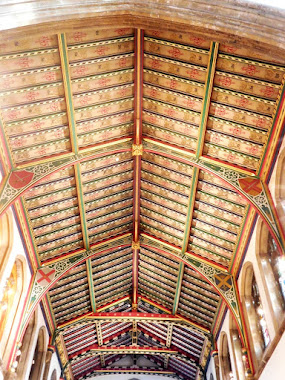THE CITY OF CHELMSFORD is the county town of the English county of Essex.
It is a
place that until November 2021 we felt. without any reason, was not worthy of a
visit and have tended to avoid, skirting it on its by-pass. It was only
recently that we realised that the place is home to a cathedral. Being nearby
on a recent tour in Essex and curious about its cathedral, we paid a visit to
Chelmsford and were pleasantly surprised by what we found.
The
cathedral, which I will discuss later, is housed in what used to be the parish
church of St Mary. The edifice is in the centre of a pleasant grassy open space.
One of the buildings on the south side of this green bears a plaque
commemorating Thomas Hooker (1586-1647), who was the curate and ‘Town Lecturer’
(a position established by the Puritans) of Chelmsford between 1626 and 1629.
Hooker
was born in Markfield, a village in Leicestershire (www.britannica.com/biography/Thomas-Hooker) and studied at the University of
Cambridge (https://connecticuthistory.org/thomas-hooker-connecticuts-founding-father/). At Cambridge, he underwent a
moving religious experience that made him decide to become a preacher of the
Puritan persuasion. He became a well-loved preacher, first serving the
congregation of a church in Esher (Surrey) before moving to preach at St Mary’s
in Chelmsford in 1626. A preacher in a neighbouring parish denounced Hooker to
Archbishop Laud (1573-1645), a vehement opponent of Puritanism, and was ordered
to leave his church and to denounce Puritanism, which he was unwilling to do. In
1630, Hooker was ordered to appear before The Court of High Commission. Soon, he
forfeited the bond he had paid to the court and, fearing for his life, fled to
The Netherlands.
In
1633, Hooker immigrated to The Massachusetts Bay Colony, where he became the
pastor of a group of Puritans at New Towne (now Cambridge, Mass.). To escape
the powerful influence of another Protestant leader, John Cotton (1585-1652),
Hooker led a group of his followers, along with their cattle, goats, and pigs,
to what was to become Hartford in what is now the State of Connecticut. They
arrived there in 1636.
When
Hooker and his followers reached the Connecticut Valley, it was still being governed
by eight magistrates appointed by the Massachusetts General Court. In 1638,
Hooker preached a sermon which argued that the people of Connecticut had the
right to choose who governed them. This sermon led to the drawing up of a
document called “The Fundamental Orders of Connecticut”, which served as the
legal basis for the Connecticut Colony until 1662, when King Charles II granted
The Connecticut Charter that established Connecticut’s legislative independence
from Massachusetts. Hooker’s importance in this process has led him to be remembered
as “the father of Connecticut.”
In
1914, the church of St Mary in Chelmsford, was
elevated to the status of ‘cathedral’. The reason for this is slightly complex
but is explained in a well-illustrated guidebook to the cathedral written by Tony
Tuckwell, Peter Judd, and James Davy. In the mid-19th century,
London expanded, and the size of its population grew enormously. Many
previously rustic parishes that became urbanised were absorbed from the Diocese
of Rochester into the Diocese of London. This resulted in a denudation of the
Diocese of Rochester. To compensate for this, Rochester was given parishes in
Hertfordshire and Essex. The Archbishop of Rochester lived in Danbury, Essex,
which was closer to the majority of his ‘flock’ than anywhere in Kent. In 1877,
the county of Essex was transferred into the new Diocese of St Albans in
Hertfordshire. However, by 1907, 75% of the population of this new diocese were
living in Essex. A further reorganisation led to the creation of two new
dioceses, one in Suffolk and the other in Essex. After some acrimonious
competition between the towns of Barking, Chelmsford, Colchester, Thaxted, Waltham
Forest, West Ham, and Woodford, it was decided that Chelmsford should become
the cathedral seat of the new Diocese of Essex. St Mary’s, where Hooker of
Connecticut once preached in Chelmsford, became the new cathedral. In 1954, the
cathedral’s dedication was extended to include St Mary the Virgin, St Peter,
and St Cedd, whose simple Saxon chapel can be seen near Bradwell-on-Sea.
The
cathedral, of whose existence we only became aware this year, is a wonderful
place to see. Its spacious interior with beautiful painted ceilings contains
not only items that date back several centuries but also a wealth of visually
fascinating art works of religious significance created in both the 20th
and 21st centuries. To list them all would be too lengthy for this
short essay, so I will encourage you to visit the church to discover them yourself.
Having
just visited Chelmsford, its cathedral, and its tasteful riverside developments,
my irrational prejudice against entering the city and preferring to avoid it by
using its bypass has been demolished. Although Chelmsford might not have the charm of cathedral cities such as
Ely, Canterbury, Winchester, and Salisbury, it is worth making a detour to
explore it if you happen to be travelling through East Anglia.
As
a last word, it is curious that although there are places named Chelmsford in
Massachusetts, Ontario, and New Brunswick, there does not appear to be one in
Connecticut; at least I cannot find one.
















No comments:
Post a Comment
Useful comments and suggestions are welcome!